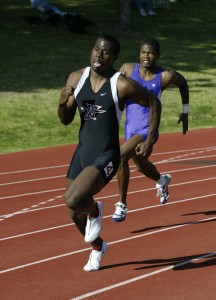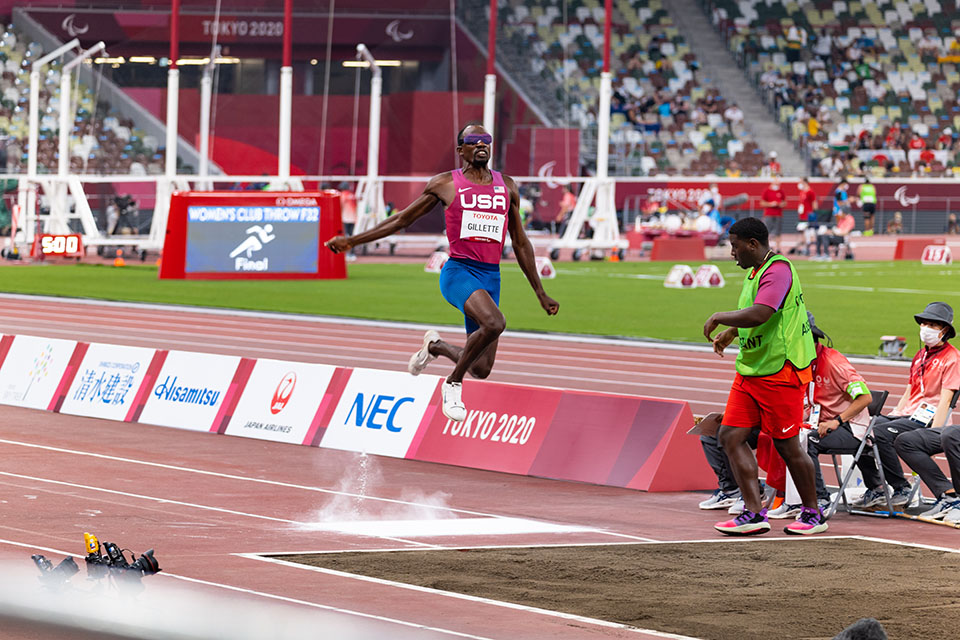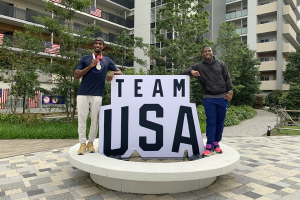A Leap of Faith: Wesley Williams Is More than a Guide for Paralympian Lex Gillette
Sixty-eight thousand plastic seats and only a few were occupied. Japan’s largest stadium was mostly empty, making whatever Wesley Williams was going to say to Lex Gillette audible and clear.
Williams placed his hands on Gillette’s shoulders, gave him a hug, then walked to his position down a red running track. Williams stopped near a square made of baking powder and flour on the flat surface. He waited for Gillette to take his leap of faith.
It was Gillette who gave the cue that he would begin his trot. Gillette leaned his torso slightly forward and raised his forearm and clenched his fist, contracting his biceps in the process. He took off, counting the steps as he galloped toward the box.
“Fly. Fly. Fly,” Williams repeated. As Gillette approached the square, Williams’ words became faster until they became: “F-f-f-f-f-f-f-fly.”
In complete darkness, Gillette flew and landed in a pit of sand.
They both knew it immediately. This was a good one.
Then, a judge stepped in and made the ruling that Gillette — a blind, four-time silver medalist Paralympic long jumper — took off with his toes outside the top of the square.
The jump would not count, and the potential gold-medal-winning leap was scratched.
Williams put his hand on Gillette’s shoulder and walked him to a bench to regroup for the five attempts he had left.
“All right, man. We’ve just got to duplicate it,” Williams said to his athlete. “We’re going to make the adjustment, and we’re going to make it happen.”
And as they have done thousands of times before, they trusted each other in pursuit of gold.
The Guide and the Athlete
Williams, 39, works full-time in a paid position as an assistant and guide for Gillette.
Growing up in Visalia, California — three hours from the Bay, three hours from L.A. — Williams had Olympic dreams as a track and field athlete.
He took those dreams to the Los Angeles area, where he ran for CSUN’s track and field team as a 100-meter sprinter and member of the Matadors’ 4×100 relay team.
“I did have some talent, and I worked very hard when I was in college,” Williams said. “And when I got into college, it’s like there are 20 guys just as fast as you. Then there are 10 other guys who are completely faster than you. Reality hits.”

Williams was an All-Big West Conference selection in 2004 as a sprinter for CSUN in 2004. (CSUN Athletics)
Williams was an All-Big West Conference selection in 2004 in both events and earned his bachelor’s degree in graphic design from CSUN in 2005. He left competitive track behind immediately after graduation and was working at Enterprise Rent-A-Car when his friend and former Visalia-area track star Jerome Avery told him about his experience as a guide runner in the 2004 Paralympics in Athens.
Avery was a hero to Williams — a track and field athlete four years his senior who had competed in the 2000 Olympic Trials.
“[I had] never heard of the Paralympics,” Williams said. “[Avery told me], ‘You wouldn’t believe what I just came back from. This is phenomenal. These blind athletes, they get busy.’”
The Paralympic Games are quadrennial, international multi-sport events for athletes with physical, vision and/or intellectual impairments. They run in parallel years to the Olympic Games.
Avery asked Williams if he would be interested in serving as a guide runner if an opportunity ever sprang up. One did in 2007, and Williams went to the Olympic Training Center in Chula Vista, home of USA Paralympic Track and Field.
This was a way for Williams to stay in the game. After graduating from CSUN, he was on the outside looking in traveling to watch his friends compete in track meets. Now, he would be back on the inside.
“I got a job with Enterprise because I had bills. That was the only reason why I was working there. But when this opportunity came, I had to take it,” Williams said. “I had to take advantage of this opportunity while I was still young. And I don’t think that that door would have opened up any other time.”
Williams was given a test run with athletes in Rio de Janeiro at the Parapan American Games, and his long jumper, Gillette, won a bronze medal. Gillette previously had worked exclusively with Avery. The next year, USA Paralympics paired Gillette with Williams at the Beijing 2008 Paralympics. Afterward, Williams and Gillette worked exclusively together.
Gillette lost his sight at 8 years old. He had 10 operations to treat recurrent retinal detachment. Following the last operation, the surgeon told him there was nothing he could do to help preserve his eyesight.
His sight deteriorated to the point where he could only see sunlight on a bright day. Gillette competed in athletics as a youth growing up in North Carolina. His mother, Verdina Gillette-Simms, who is also blind, found adaptive sports and recreation opportunities for her son. He caught the attention of Raleigh’s Athens Drive High School’s basketball coach, Brian Whitmer, while testing for the Presidential Physical Fitness Award. Whitmer guided Gillette into training and competition in track and field.
Three years after winning a silver medal in the long jump at the 2004 Paralympic Games and setting a new American record at 6.24 meters, he met Williams.
“When I first met Wesley in 2007, he had a very infectious personality. He is a really great person and a great human being. He had a lot of the same goals for track and field,” Gillette said. “He’s a competitor. He competed for Northridge. He’s an athlete. And so, my goals became his goals. Although he wasn’t able to go to the Olympics or anything like that, he’s experiencing all of those things and more within our relationship.”
More than Words
Williams’ great-grandmother Emma Williams was blind. Growing up, he watched her clean, cook and complete everyday chores. His experience with her helped him understand that although Paralympic athletes have a disability, they also have ability.
He already had understanding and compassion going into training with athletes who have physical, vision or intellectual impairments.
Williams, though, said he needed to enhance his communication skills and be more exact as he delivered directions that help create a clear picture for his athlete.
He is part trainer, part sports psychologist, and part coach and strategist. “Master builder,” is how Gillette describes Williams, who spends time in the training facility, on the road and in the competition with him.
Paralympic sprinters can run tethered to their guide by a six-inch elastic band attached to their fingers, or they can run to their side, unattached. The guide mirrors the steps of the runner. When running with Gillette, Williams doesn’t wear a band. He starts with his right foot while Gillette starts with his left foot, so he has a slightly slower start to give Gillette more room. They pump their arms in harmony, while Williams provides verbal communication if needed.
In each event, Gillette and his fellow competitors wear blindfolds to keep the playing field even in events for the visually impaired.
“You have to learn what it is to run with someone and to communicate and just be aware of any type of errors happening,” Williams said. “We’ve run and had tethers snap. We’ve had mishaps where Lex landed on the side of the pit. There’ve been accidents [with other athletes] where in long jumping, the guide didn’t get out of the way and gets uppercutted by the athlete and walks away with a shiner.”
On the long jump, Williams lines Gillette up at his starting point, gives him final words of encouragement, then heads to the front of the sandpit. From there, he claps to give his athlete some final motivation before he begins. Gillette runs down the track and hears his friend’s words: “Fly. Fly. Fly.” As Gillette feels the powder under his foot, he obliges.
“Fly” has a dual meaning for Gillette.
“I equate gravitational pull to naysayers and people who try to impose on you their own expectations, on what it is that you can do and what you can become,” Gillette said. “Wesley and I work together, and for a moment in time, I’m running down the runway, and I’m flying through the air — and that’s me defying gravity because when I’m out there, nobody can tell me that I can’t long jump. I’m going to defy gravity and continue to fly.”
It’s more than words, Gillette said, that Williams uses to make him a better athlete.
“I don’t think people understand. People just think he stands at the take-off board and claps and yells. But behind the scenes, he’s running with me on the track doing the 150-meter repeats, or running the 80-meter hills, or helping in the weight room doing all the drills. That’s why I’m able to do what I do in the long jump.”
It is a relationship built on faith and trust. And like many relationships, it’s not all rainbows and unicorns. The journey has had tense moments. Williams’ personality is more intense than Gillette’s even-keeled temperament. That difference came to a head in 2011, when Gillette didn’t medal in the long jump at an event and insisted that couldn’t happen again. Williams took that to mean ramping up the intensity of training, to which both had to compromise to find a level on which they could agree. Williams remembered Gillette later telling him about the incident, “You know, I almost fired you.”
But something is working. Gillette won silver medals with Williams in Paralympic Games at London in 2012 and Rio in 2016.
The competitive duo’s pursuit of gold was delayed by the pandemic, which postponed the Tokyo 2020 games to August 2021.
The Silver Lining

Gillette long jumps with Williams guiding him at the 2020 Paralympic Games in Tokyo. (Photo courtesy of Olympic Information Services)
In 2011, Gillette set a world record with a jump of 6.73 meters at the Desert Challenge Games in Mesa, Arizona.
Gillette stood to win gold after his jump of 6.34 meters in London, only to be bested by Ukraine’s Ruslan Katyshev, whose final attempt went 6.46.
In 2015, Gillette tied his own world record in competition.
In Rio in 2016, Williams went through his traditional communication with Gillette from the sand. Williams remembered an enthusiastic crowd — a soccer-like atmosphere — lifting their voices and making noise, thus drowning out his voice. Gillette still jumped 6.44.
“Last jump, they know [Brazilian Ricardo Costa de Oliveira] has to come down and take it from Lex, and they’re quiet as a church mouse,” Williams remembered.
Costa de Oliveira jumped 6.52 to win gold.
Five years later in Tokyo, Williams and Gillette stood on the track about 30 meters from each other at Japan National Stadium. Because of the ongoing pandemic, there were no fans in the giant sports venue.
After a first jump where he scratched, the 36-year-old Gillette jumped 6.17 in his second attempt. However, China’s Di Dongdong, 27, jumped 6.35 in his first, and later 6.47 on his fourth. In Gillette’s sixth and final attempt, he jumped 6.16.
Silver, again.
Williams could feel his disappointment, but there’s another crucial part of his role — friend.
“He put so much weight on it, and he kind of felt like he let people down. I just told him, ‘We’re proud of you. You’ve got to understand we could have left with nothing,’” Williams said.
There was a silver lining, Gillette said. Because of the pandemic, the traditional medal ceremony was changed. Instead of Paralympics officials placing the medals around the medalists’ necks, for the first time, guides presented the medals to their athletes.
“For him to touch the medal first, for him to have his hands on it first and pass it over to me, without him, I wouldn’t be able to achieve any of this,” Gillette said.
Guides in track events also receive a medal. However, guides in field events — like the long jump — don’t. Gillette said it is his goal to change that for the 2024 Paralympics in Paris, where he will go for gold again, with Williams.

Gillette, left, and Williams pose for a photo at the Paralympic Village in Tokyo in August. (Photo courtesy of Wesley Williams)
He and Williams both have deep faith — in sport, in each other and in God.
Gillette often prayed about regaining his sight. And someone listened.
“It’s interesting that when you pray for certain things, those prayers, they’re answered, but they’re answered in a way that you didn’t initially think,” Gillette said. “I might have wanted eyesight. I got it, but I got it in the form of an amazing person who has that eyesight that they lend to me on a daily basis. And through his eyes, I’ve been able to experience so much in this world. I’ve been able to win a ton of medals, been able to go inside of rooms and meet people I would have never imagined meeting in my lifetime. And it’s all because 20/20 eyesight that is within Wesley.
“And it goes beyond sight,” Gillette continued. “He is a friend. He is a brother. And you don’t find many people like that in this world that we live in.”


 experience
experience